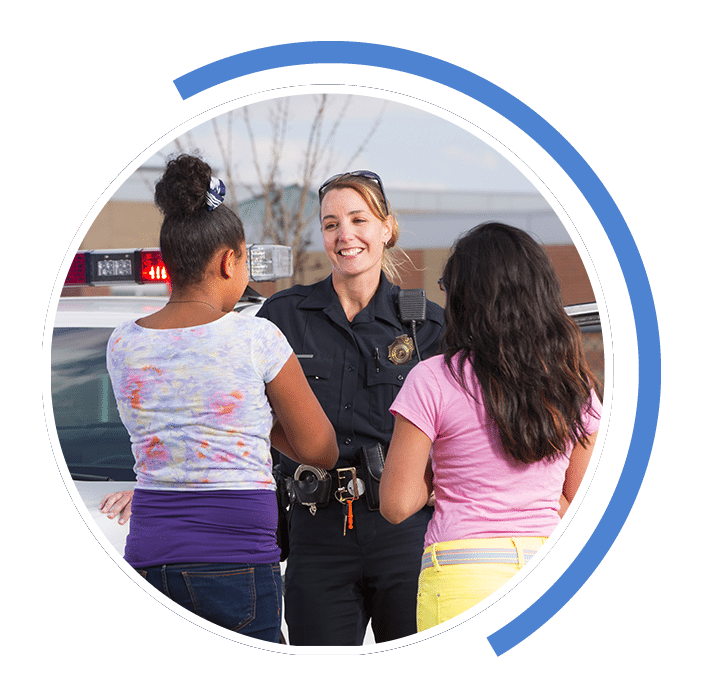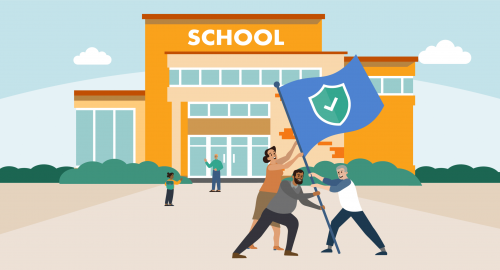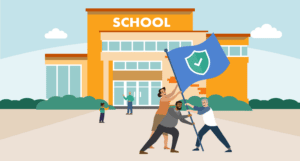Listen to this blog
4 minutes
Engaging the community in school safety brings diverse insights and enriches safety strategies. This collaboration pools resources, amplifies safety measures’ effectiveness, and boosts awareness and understanding of safety protocols among stakeholders, thus strengthening the security posture of schools.
Involving the community in school safety also promotes a sense of shared responsibility for ensuring the safety and wellbeing of students, staff, and faculty. When parents, local businesses, law enforcement agencies, and other community members actively participate in safety initiatives, it creates a strong support system that can not only prevent incidents but also respond effectively if one were to occur.
Let’s explore how engaging with our community can lead to more impactful outcomes.
Police and First Responders
The collaboration between schools and law enforcement is crucial, creating a dynamic safety net that evolves with our understanding of security. Through strategic partnerships and interventions, schools can leverage the expertise of law enforcement to develop comprehensive safety plans that:
- Establish a common language through Standard Response Protocols (SRP)
- Ensure clear communication via panic alert technology like Raptor Alert
- Empower first responders with detailed tactical maps through Collaborative Response Graphics® (CRG®)
These strategies facilitate effective drills, improve emergency communication, and provide law enforcement with a deep understanding of school layouts, thus paving the way for a symbiotic relationship between law enforcement and schools. This approach fortifies the safety of schools and supports a framework that respects the nurturing atmosphere of schools while ensuring robust security measures are in place.
Role of Parents and Community in Safety Planning
Parents as Safety Advocates
Parents play an indispensable role as advocates for school safety. Their engagement is pivotal in devising safety strategies that are effective and contextually relevant to the school community’s specific needs. This partnership between schools and parents facilitates the creation of a tailored safety framework that resonates with and is supported by the wider community.
Schools can create opportunities for parents to become safety advocates in several ways.
- Encourage parents to discuss their school’s safety measures with their children by providing flyers or learning opportunities for families to discuss key safety topics. This also helps parents gain insight into the actionable safety plan policies and enables district personnel to check policy clarity from their feedback.
- Create opportunities for parents to join a Parents School Safety Advocacy Board and include those members in safety planning meetings.
- Invite parents to practice emergency response protocols such as reunification alongside your district’s staff. By enabling parents to volunteer for these sessions, not only are you reaffirming their trust in your district’s ability to protect their children, but your district will also benefit from having a larger, more diverse pool of experienced voices in the process.
Community Resources and Expertise
Leveraging community resources and expertise significantly augments the capacity of schools to plan for and respond to safety concerns. Collaborations with local businesses and technology providers introduce innovative solutions to school safety challenges, thereby enhancing the resilience and responsiveness of educational institutions to potential threats.
The Final Report of the Sandy Hook Advisory Commission notes the successful implementation of Safe School Design and Operations (SSDO) strategies requires the support of ‘local champions.’ “Each community or school district should have a small standing committee or commission, comprised of individuals representing the school community, law enforcement, fire, EMS and public health, whose responsibility is to ensure that the SSDO standards and strategies are implemented in their community.” (31-32)
To benefit from this community support, schools should:
- Establish a standing committee or commission with representatives from the school community, law enforcement, fire, EMS, and public health to support the implementation of Safe School Design and Operations (SSDO) strategies.
- Collaborate with local businesses and technology providers to introduce innovative solutions to school safety challenges.
- Develop and maintain emergency operations plans that include clear protocols for managing various hazardous situations, such as natural disasters, accidents, and active shooter scenarios.
- Foster communication strategies to share safety protocols and strategies with the broader community, aiming to reduce opposition to essential security measures.
Building Trust Through Community Collaboration
Trust as the Foundation
The establishment of trust among schools, parents, and community members is foundational to successful safety planning and crisis management. Trust is cultivated through transparent communication and collaborative efforts, fostering a sense of shared purpose and commitment to the safety and well-being of students.
Promoting regular safety planning meetings and transparent sharing of safety protocols are crucial in building a collaborative environment. Enabling community members to engage in safety discussions helps ensure safety measures are comprehensive, current, and communally endorsed.
David Wresinski, District Safety Coordinator at Robinson Independent School District in Texas, emphasized the importance of uniting around the common goal of fostering safe schools. “Our Campus Safety Coordinator’s leadership with using Raptor has helped to make our other staff members feel like they are a true part of the Campus Safety Team. To me, it’s super important to make sure that everyone is invested, and Raptor allows them to feel that investment. They all have confidence in it and believe that it’s an integral part of our safety system.”
Shared Responsibility in School Safety Among Community Members
A collective approach not only distributes the burden of safety measures but also enhances the preparedness and resilience of the school community. The Dayton Independent School District in Kentucky had this to say about leveraging technology to enhance school security, “Raptor has provided peace of mind to staff and parents, knowing that we are screening everyone coming into our buildings. With how simple it is to use, we ended up implementing all four modules throughout our district with ease.”
To learn more about the best practices related to collaborating with local first responders, watch Raptor’s School Safety Today webinar, Transforming School Safety: The Four-Pillar Model, with Hutto, TX Police Chief, Jeffrey Yarbrough.
Related Resources
Guide to Bridging the Gap Between Schools and Public Safety
Collaborating with public safety improves school emergency preparation, response, and recovery.

Listen to this blog
4 minutes







